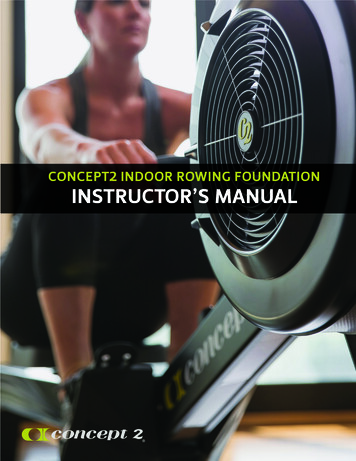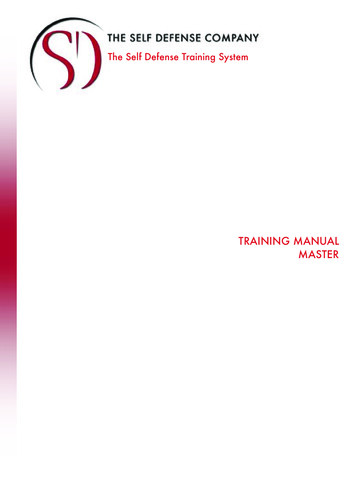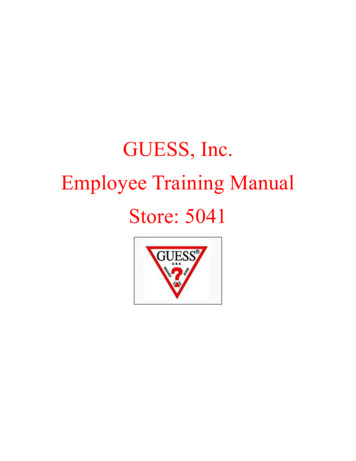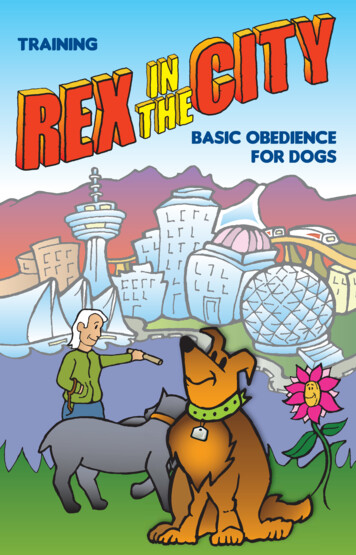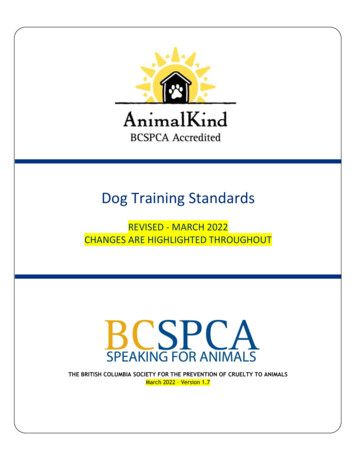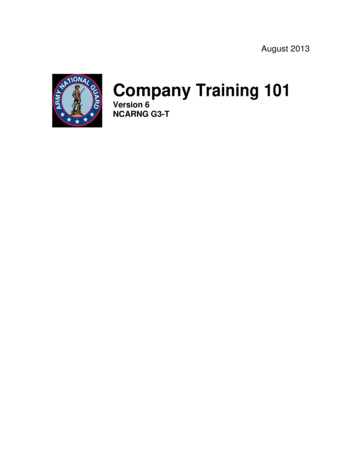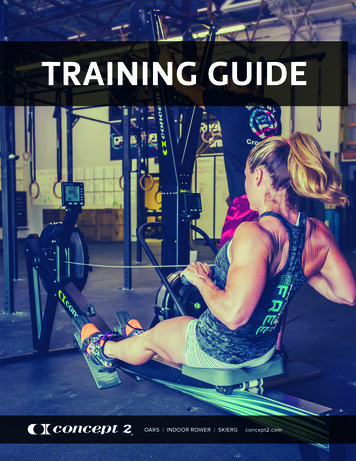
Transcription
TRAINING GUIDEOARS INDOOR ROWER SKIERGconcept2.comTraining Guide1
Getting StartedThis guide will help you to:1.2.3.4.5.Set your goals.Understand the types of workouts you can do to achieve your goals.Determine the number of workouts of each type that you should do per week.Get started and track your progress.Evaluate your progress and adjust your plan as needed.Consult a physician before performing any exercise program, including the programs at concept2.com or in thisTraining Guide. It is your responsibility to evaluate your own medical and physical condition, or that of your clients,and to independently determine whether to perform, use or adapt any of the information or content at concept2.com.Any exercise program may result in injury. By voluntarily undertaking any exercise displayed at concept2.com, youassume the risk of any resulting injury.Setting Goals and Choosing WorkoutsWhat do you want to achieve with your rowing and/or skiing? And what are the types of workouts thatwill help you achieve those goals?1.Achieve and maintain general fitness: Use a variety of workout types, including intervals. Gradually increase your total workout time and/or intensity to keep improving. Aim for a workout frequency of at least every other day and preferably 5-6 days per week (thiscan include other types of exercise).2.Lose weight and keep it off: Aim for at least one workout per day, with a rest day each week as needed. Consider completing two short workouts in one day instead of one long one, since each workoutraises your metabolic rate for a period of time after the exercise. Burn more calories in two ways: go longer or go harder. We recommend some of each. Use a variety of workouts to keep it interesting.3.Train or condition for another sport: Build general aerobic fitness to support your more sport-specific training. Design your workouts based on the work you do in your primary sport, such as short, hardsprints for tennis, steady 10k pieces for running, etc.4.Train for competitive rowing or skiing: Take advantage of the fact that the indoor rower and SkiErg are both powerful training tools fortheir respective sports because they provide a means for accurately monitoring training progress,while offering a high quality workout at the same time. Test yourself at race distances to determine your athletic potential or to rank members of a crew. Supplement other training modalities such as roller-skiing and running with the SkiErg. Workoutscan also be incorporated into strength training to maintain specific strength. When the weather isbad or the days get short, it’s a great indoor option. Use your coach’s training plan, if available. Without formal coaching, we suggest a combinationof workout types for a total of 8-11 workouts per week, depending on your goals, current level offitness, and available time. At least three of these workouts should be strength or cross-trainingsessions.2
5.Rehab from injury: Please don’t undertake a rehab program without input and approval from your medical advisors. Take advantage of the fact that both the indoor rower and the SkiErg offer an impact free, usercontrolled motion. The SkiErg can be adapted for use with minimal or no leg involvement, making it a great trainingtool for those with lower body injuries or issues. You can use a stool or other seat, or pull awheelchair up to the SkiErg. Review the adaptations available for using the indoor rower (available rowing). The indoor rower allows rowingwith full or partial leg compression—or even arms only if desired. Be sure to start easily and build slowly.Types of WorkoutsA wide variety of workouts can be done on the indoor rower and SkiErg, from long steady pieces toany kind of interval. The Performance Monitor offers extensive flexibility for setting up these workouts,displaying performance data during the workout, and saving your results for later review and analysis.Interval workouts are composed of alternating periods of work and rest (or very easy effort). Bothwork time and rest time may be varied as desired. Here are some common types of intervals, along with acollection of workouts to choose from.Long intervals – 4 minutes in length and longer: 4 x 4 minutes, with 2-4 minutes rest 4 x 5 minutes, with 3 minutes rest 3 x 1500 meters, with 3-5 minutes rest 2 x 2000 meters, with 4-6 minutes restShort intervals – less than 4 minutes in length: 1 minute hard/1 minute easy 6 x 500 meters, with 2 minutes rest 5 x 3 minutes, with 2-3 minutes rest 30 seconds hard/1:30 easyShort rest intervals – rest interval is very short, in the range of 10-30 seconds. This allows thebody to clear some of the lactate, but the heart rate stays pretty high: (1:40 hard/:20 easy) x 10 1 minute hard/30 seconds easy 20 strokes hard, 5 strokes easy 8 x (:20 hard/:10 easy). Also known as Tabata intervals.Variable length intervals – pyramids, step-ups, step-downs. There are any number of creativepossibilities! 1-2-3-4-3-2-1 minutes hard, with rest equal to the work time 5 minutes, 4 minutes, 3 minutes, 2 minutes, 1 minute hard, with 2 minutes rest in between 500 meters, 1000 meters, 1500 meters, 1000 meters, 500 meters, with 2-4 minutes rest inbetween work intervals 3x500m; 3x250m, with 2 minutes rest in betweenTraining Guide3
Long, steady workouts emphasize continuous work with minimal rest. The level of intensity mayvary from an easy conversational pace to an intensity where you really don’t feel like talking but can justmaintain the effort for the planned distance or time. Your pace for long, steady work will be lower thanwhat you can do in an interval workout.Steady state – long, steady exercise, with no (or short) breaks: 30 minutes steady 5000 meters 20 minutes, 1 minute break, 20 minutes 10,000 metersVariable/alternating: 5000 meters, taking 20 harder strokes at the beginning of each 1000 meters (3 minutes @ 22-24 spm, moderate steady pace, 2 minutes @ 25-27 spm increasing youreffort, 1 minute @ 28-30 spm and higher intensity) and repeat 5-8 times. Note: for SkiErg,spm should be 35-38, 39-42, 43-46. 6000 meters, taking 10 harder strokes at the beginning of each 500 meters Alternate 3 minutes conversational pace with 1 minute harder pace for a total of 32-40minutesWorkouts combining the indoor rower and SkiErg: if you have access to both the indoorrower and the SkiErg, there are some great workouts that combine the two of them. The motions ofrowing and skiing are nicely complementary—rowing involves prying open at the hips, while skiinginvolves crunching forward to close the hips. And both use many muscle groups, from upper body,through the back and core, to the lower body. 10 minutes ski, 9 minutes row, 8 minutes ski, 7 minutes row 2 minutes ski, 1 minute row.Rest only as long as it takes you to switch machines 2000 meter row, 2000 meter ski, 1500 meter row, 1500 meter ski, 1000 meter row, 1000 meterski, 500 meter row, 500 meter ski. (For a shorter workout, start with the 1500s.) 1000 meter row, 100 meter ski, 900 meter row, 200 meter ski, 800 meter row, 300 meter ski 100 meter row, 1000 meter ski You can also do any of the above intervals, switching between the machines as you goDesigning Your Training PlanThe following steps will lead you through the process of designing your own training plan.1. From the list of personal goals on pages 2-3 choose the one that best matches your personalfitness goals.2. See chart on page 6 for suggested types and frequencies of workouts for your goal. Note that insome cases you can choose from Level 1, which targets those who are newer to training in general,or Level 2, which is for those with more experience. Create a weekly planning calendar to assign which workout types you will do on each day ofthe week, as shown in the following example. Example: Goal Weight loss4
yLongerVaried3. Choose your workouts from the list of suggestions for each workout type (page 3-4) and fill in yourcalendar for the next four weeks. You can also find daily suggestions at Concept2’s Workout of the Day(concept2.com/wod) to add variety. For example:Week 1MonTuesWedThursFriSatSun1 minutehard/1minuteeasy5000meters4x4minuteswith 2-4minutesrest inbetween5000meters,taking 20harderstrokes atthe beginning ofeach 1000meters1-2-34-3-2-1minuteshard, withrest equalto worktime30minutessteady6000meters,taking 10harderstrokes atthe beginning ofeach 500metersSee page 7 for a complete example.4. Start at an intensity and volume that matches your current level of experience and fitness, and thengradually build up from there. So, if this is your first training program, start easily!5. Keep a training log that includes comments about how you feel, what you thought about the workout,what was hard, and what was easy. Concept2 offers a free online logbook at concept2/logbook.6. Establish a plan for monitoring progress with a set of periodic test pieces. Choose several workouts to use as your benchmarks. For example, you might choose: a 500m time trial: short and intense the rowing standard of 2000m: a good measure of aerobic fitness 30 min steady row for time Pick a week to do these benchmark efforts, spread out throughout the week. Record yourtimes or distances for all of these. You can also use the Concept2 Online Ranking to compareyourself with others of your age around the world. Train for 3-5 weeks and then test yourself again with the same workouts, and see how you’redoing.7. If you’re not making the progress you hoped to see, make changes in the program. If you feel tired a lot of the time, try going easier on your longer workouts and cut out one ofthe interval sessions. Make sure you feel fresh for the short harder workouts. If you feel like you can do more without getting exhausted, then gradually build the distanceand intensity of your workouts, or add another workout or two to the week. You can also adjust the ratio of intervals to longer work. Different people need differentamounts of each type of workout. It will be important for you to experiment, keep track ofwhat you do, see what works and what doesn’t. Have fun with it!Using the Online World Ranking as a GaugeThe Online World Ranking is a data bank for performances at 14 different distances/times. By doingthese pieces, you can compare your performance with the records and medians for each. This is anothergreat way to monitor your progress—and, in addition, it can help identify your relative strengths andweaknesses along the spectrum of ranked distances.Training Guide5
TRAINING GUIDENumber of Workouts Per WeekWorkout Type:LongIntervalsLongerShortShort Rest Variable SteadyIntervals Intervals Intervals WorkLongerVariedWorkTotalSessionsNotesYour Goals:General fitness—Level 1111115Generalfitness—Level 2111216Weight lossTraining foranother sport—L1Training foranother sport—L2Training forRowing orSkiing—L1Training forRowing orSkiing—L2111111111111122121741151421014312Good variety in workout types; graduallybuild volume and intensity.Variety of workout types with moreworkouts per week.Both volume and intensity of exercise helpto burn calories. Two sessions per day canhelp even more.Assumes that you are doing 2-3 additionalworkouts related to your primary sport.Number of erg workouts may dependon what other workout types are in yourprogram.Total volume and intensity of workdepends on your current fitness level,training history, and individualizedfitness needs.Note: Level 1 (L1) targets those who are newer to training. Level 2 (L2) is for those with more experience.6
Sample PlanSample two week training plan for a goal of weight loss:MTWThFSaSuWeek 11 minutehard/1minuteeasy5000meters4x4minuteswith 2-4minutesrest inbetween5000meters,taking 20harderstrokes at thebeginning ofeach 1000meters1-2-34-3-2-1minuteshard,with restequalto worktime30minutessteady6000 meters,taking 10harderstrokes atthe beginningof each 500metersWeek 26 x 500meters,with 2minutesrest30minutessteady4x5minutes,with 3minutesrest(3 minutes @22-24 spm,moderatesteady pace,2 minutes @25-27 spmincreasingyour effort,1 minute @28-30 spmand higherintensity) andrepeat 5-8times5, 4, 3, 2,1 minutehard,with 2minutesrest20 minutes, 1minutebreak,20 minutesAlternate 3minutes conversationalpace with 1minute harderpace for atotal of 32-40minutesAppendix: Training Plan Resources1. Concept2 provides additional free online resources for training and owers/training/tips-and-general-info/stretchingHow to Row ing/tips-and-general-info/how-to-row-harderUsing the Force ning Heart Rate he Anaerobic ining Guide7
Interval ning/tips-and-general-info/interval-trainingRowing for Specific g/rowing-for-specific-goals/general-fitnessRowing for Other Sports and altraining-calendarCalculators (Pace, Calorie, VO2 Max, Weight Adjustment, ng/calculators/vo2max-calculatorWe also continue to add training content to our blog (http://www.concept2.com/news/tags/training).Some example topics: 10-20-30 Training Concept2 Employee Training: 7 Tips to Improve Your Rowing Glutes: We All Have ‘em, But Do You Use ‘em?2. Online resourcesThere are additional online resources worth checking out, including services where you can pay
2 Consult a physician before performing any exercise program, including the programs at concept2.com or in this Training Guide. It is your responsibility to evaluate your own medical and physical condition, or that of your clients,
